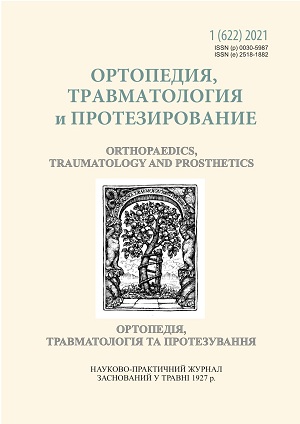Comparative evaluation of polymethylmethacrylate and composite bone cements. Review of the experimental studies results
DOI:
https://doi.org/10.15674/0030-59872021186-91Keywords:
Bone cement, polymethylmethacrylate, β-threecalciumphosfates, experimentAbstract
Current article is a review of experimental studies of different bone cements types and their combinations. Providing of bone fragments stable fixation at osteosynthesis in cases of difficult multifragmental fractures, arthroplasties and other implants using especially in the osteoporosis conditions is a main task of orthopaedic surgery procedures. Polymethylmethacrylate (PMMA) is the first material that is answered to these requirements. The evolution of bone cements resulted in creation of a new composite substance — combination of PMMA and β-threecalciumphosfates (β-TCPh). Combination of these two components allowed to provide high bioabsorbal, osteoconductive and osteointegrative properties along with sufficient durability. In the analyzed works the properties of composite cement CalCemex were evaluated in vivo experiment. It was found that in the case of PMMA penetration of bone tissue into the polymer structure did not occur. Under the conditions of using bone cement with β-TCF admixture, the formation of bone tissue was observed not only on the surface of the implant, but also in the external and internal pores. It is the presence of pores in CalCemex that the authors explain the possibility of penetration of cellular elements, blood vessels and bone formation. Moreover, β-TCPh is included into this material and it is bioresorbed by osteoclasts. This leads to the release of calcium and phosphorus ions and, consequently, simplifies the attachment of the newly formed bone to the bone cement. We assume that composite cement like CalCemex type is a promising material for the treatment of various types of fractures and replacement of bone defects. It should be mentioned that research in this area is ongoing and intensive work is underway to synthesize and study the results of clinical application of composite bone cements with maximum bioactive properties that will not only strengthen bone tissue but also perform osteointegrative function. Key words. Bone cement, polymethylmethacrylate, β-threecalciumphosfates, experiment.
References
- Dall'Oca, C., Maluta, T., Cavani, F., Morbioli, G., Bernardi, P., Sbarbati, A., Degl'Innocenti, D., & Magnan, B. (2014). The biocompatibility of porous vs non-porous bone cements: A new methodological approach. European Journal of Histochemistry, 58(2). https://doi.org/10.4081/ejh.2014.2255
- Dall'Oca, C., Maluta, T., Micheloni, G. M., Cengarle, M., Morbioli, G., Bernardi, P., Sbarbati, A., Degl'Innocenti, D., Lavini, F., & Magnan, B. (2017). The biocompatibility of bone cements: Progress in methodological approach. European Journal of Histochemistry. https://doi.org/10.4081/ejh.2017.2673
- Cristofolini, L., Morellato, K., Cavallo, M., & Guerra, E. (2020). Reconstruction of proximal humeral fractures with a reduced number of screws and a reinforced bone substitute. Medical Engineering & Physics, 82, 97-103. https://doi.org/10.1016/j.medengphy.2020.06.002
- Li, Y., Lei, W., & Wang, Z. (2013). In vivo experiment of porous bioactive bone cement modified by bioglass and chitosan. Zhongguo Xiu Fu Chong Jian Wai Ke Za Zhi, 27(3), 320–325
- Heini, P. F., Wälchli, B., & Berlemann, U. (2000). Percutaneous transpedicular vertebroplasty with PMMA: Operative technique and early results. European Spine Journal, 9(5), 445-450. https://doi.org/10.1007/s005860000182
- Cohen, J. E., Lylyk, P., Ceratto, R., Kaplan, L., Umansky, F., & Gomori, J. M. (2004). Percutaneous vertebroplasty: Technique and results in 192 procedures. Neurological Research, 26(1), 41-49. https://doi.org/10.1179/016164104773026516
- Lopez-Heredia, M., Sa, Y., Salmon, P., De Wijn, J., Wolke, J., & Jansen, J. (2012). Bulk properties and bioactivity assessment of porous polymethylmethacrylate cement loaded with calcium phosphates under simulated physiological conditions. Acta Biomaterialia, 8(8), 3120-3127. https://doi.org/10.1016/j.actbio.2012.05.007
- Lye, K. W., Tideman, H., Wolke, J. C., Merkx, M. A., Chin, F. K., & Jansen, J. A. (2011). Biocompatibility and bone formation with porous modified PMMA in normal and irradiated mandibular tissue. Clinical Oral Implants Research, 24, 100-109. https://doi.org/10.1111/j.1600-0501.2011.02388.x
- Cimatti, B., Santos, M. A., Brassesco, M. S., Okano, L. T., Barboza, W. M., Nogueira-Barbosa, M. H., & Engel, E. E. (2017). Safety, osseointegration, and bone ingrowth analysis of PMMA-based porous cement on animal metaphyseal bone defect model. Journal of Biomedical Materials Research Part B: Applied Biomaterials, 106(2), 649-658. https://doi.org/10.1002/jbm.b.33870
- Wall, V., Nguyen, T., Nguyen, N., & Tran, P. A. (2021). Controlling antibiotic release from Polymethylmethacrylate bone cement. Biomedicines, 9(1), 26. https://doi.org/10.3390/biomedicines9010026
- Sa, Y., Yu, N., Wolke, J., Chanchareonsook, N., Goh, B. T., Wang, Y., Yang, F., & Jansen, J. A. (2017). Bone Response to Porous Poly(methyl methacrylate) Cement Loaded with Hydroxyapatite Particles in a Rabbit Mandibular Model. Tissue engineering. Part C, Methods, 23(5), 262–273.
Downloads
How to Cite
Issue
Section
License

This work is licensed under a Creative Commons Attribution 4.0 International License.
The authors retain the right of authorship of their manuscript and pass the journal the right of the first publication of this article, which automatically become available from the date of publication under the terms of Creative Commons Attribution License, which allows others to freely distribute the published manuscript with mandatory linking to authors of the original research and the first publication of this one in this journal.
Authors have the right to enter into a separate supplemental agreement on the additional non-exclusive distribution of manuscript in the form in which it was published by the journal (i.e. to put work in electronic storage of an institution or publish as a part of the book) while maintaining the reference to the first publication of the manuscript in this journal.
The editorial policy of the journal allows authors and encourages manuscript accommodation online (i.e. in storage of an institution or on the personal websites) as before submission of the manuscript to the editorial office, and during its editorial processing because it contributes to productive scientific discussion and positively affects the efficiency and dynamics of the published manuscript citation (see The Effect of Open Access).














